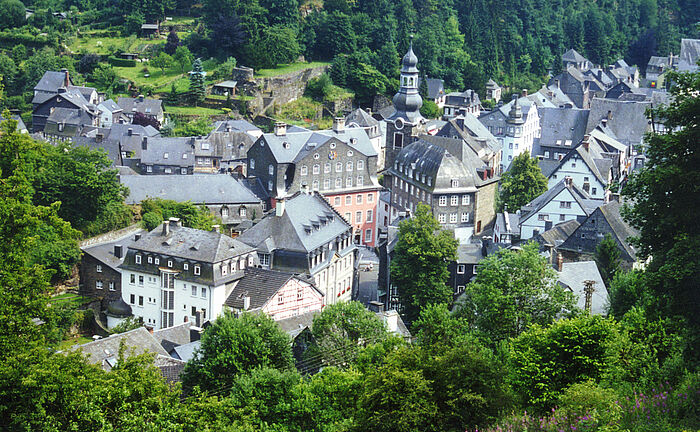Breadcrumb
Monschau

„Back home again from far countries, I am again totally amazed by the view of my home town. From the height of the Haag I look down into the valley, drunk of joy. Yes, it still is there, my old wonderful home town”. With these words of deep emotion the well-known regional writer Ludwig Mathar, born in Monschau, in 1927 described his home town in much appreciation. Today this is more or less the same.
Letting the eyes wander over the North Eifel, the gaze will be caught by framework, slate, dry stone walls and narrow alleys in Monschau, by lines of trees swaying in the wind, extensive woodlands and barren high plains in the Hohe Venn. Where ever one goes, the unmistakable character of the Eifel becomes visible in the Monschauer Land (region around Monschau) and during the changes of the seasons appears to the viewer as a perfectly staged play.
Lucky, the one who lives in the country side! The open landscape of the North Eifel is structured by an almost 400 km long network of hedges: at least as much impressive are the more than 500 protective hedges around many houses in the municipal area of Monschau, which carefully surround old and new houses like green walls. Thanks to some especially imposing hedges and various other things, Höfen has been awarded the title “Bundesgolddorf”. The meadows full of daffodils in the valleys Perlenbachtal and Fuhrtsbachtal are virtually outside the front door. The Stehling near Mützenich rises from the idyllic landscape of low mountains with 666 meters as the highest point in the city region Aachen. The monastery “Gut Reichenstein” (estate Reichenstein) is dominated by the 100 years old Eifeldom (Eifel cathedral) in Kalterherberg.
By the example of the 800 years old castle of Monschau the city’s claim to combine art, culture and nature as a model of success, can easily be understood. For ten years in summer the festival has taken place in the inner courtyard of the castle. In the valley the Red House rises up not less majestic; its builder, the cloth manufacturer Johann Heinrich Scheibler, in the middle of the 18th century, employed about 6000 people. The absolutely lime-free water of the Rur represented the guaranty for the upswing in the cloth industry.
Numerous art exhibitions, but also quite a number of provocative street actions have increased Monschau’s importance as a cultural city and today each citizen of Monschau is filled with pride that it was no one less than the famous project artist Christo, who in the year of 1971 wrapped the Haller and the castle with polypropylene foil.
A stroke of luck for the region and Monschau was the establishment of the national park Eifel in the year of 2004, the fortunate result of which is that Monschau now defines the centre between two outstanding protective areas. Towards the Belgian border the Hohe Venn opens up, which already in 1957 was declared a natural preserve on European level.
Today on nice days thousands of people push their way through the historic town centre, but Monschau does not want to become a town-museum; this would be below value. Here the circle closes again at Ludwig Mathar, who rightfully created a literary monument to his town: „Then you really feel a tremendous longing, beating of the heart and ravenous hunger, to immerse into this wealth of delights.
